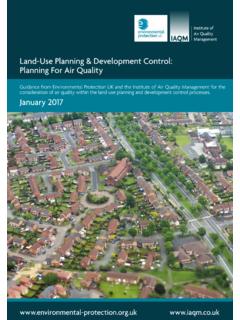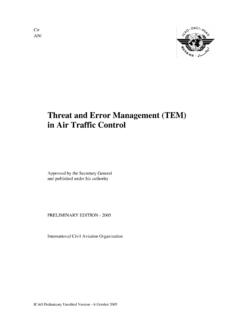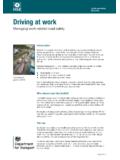Transcription of Reducing risk in temporary traffic management …
1 Health and Safety Executive Reducing risk in temporary traffic management operations HSE information sheet Construction Information Sheet No 53. Introduction Designers and contractors should assess the risks involved in projects to develop systems of work that Carriageways can be dangerous places in which to present the lowest risks to workers and road users, for work and usually require some form of temporary each activity, in each specific road environment. traffic management to control and divert traffic around a work area. Those involved in setting out, maintaining Those doing the work must receive relevant and removing traffic management schemes are information, instruction and training to ensure they are particularly at risk as they work in a live traffic able to perform their assigned tasks and be provided environment. with appropriate equipment. They should follow safe systems of work. This information sheet outlines the key factors to address when planning, managing and carrying out temporary traffic management operations.
2 Design and planning The guidance is for clients, designers, contractors Those planning road and street works should assess and workers involved in establishing, maintaining the risks associated with the installation, management , and removing static temporary traffic management alteration and removal of the temporary traffic arrangements at road and street works. management and, where reasonably practicable, eliminate or reduce them. Any remaining significant This information sheet is not prescriptive, nor is it a risks must be controlled, through careful planning and technical standard. It is not a comprehensive list of the management of the works. health and safety issues that may be encountered. Those designing and planning road works and traffic management layouts should: What the law requires n Consider: road layout, location of junctions and All work associated with establishing, altering, pedestrian crossings etc, whether permanent maintaining and removing static traffic management markings and signs will need to be altered or systems needs to be undertaken in ways that ensure removed, traffic flows, local attractions or events the health and safety of both workers and road users.
3 That may affect the work. In addition to highway legislation1 such as the n Liaise with the traffic management contractor, New Roads and Street Works Act 1991 and The main contractor, highway authority and police, to traffic Signs Regulations and General Directions indentify appropriate traffic management systems 2002 (TSRGD), clients and their agents, designers, for projects (eg the use of variable message signs contractors and workers need to ensure that they (VMS), speed cameras, emergency procedures, comply with their duties under health and safety law. diversion routes etc). This requires that duty holders assess work-related risks and eliminate, reduce and control significant n Eliminate the need, where reasonably practicable, risks, so far as is reasonably practicable. for operatives to cross high speed carriageway roads on foot to set out and remove traffic Clients should appoint designers and contractors management layouts and equipment and consider: with the necessary experience, skills and knowledge - specifying the use of remotely-operated to plan and complete the work safely, and provide roadwork signs.
4 Sufficient information, time and resources to do so. - the delivery of traffic management equipment so as to reduce the need to carry it across the carriageway, eg laying it down in the central 1 of 6 pages Health and Safety Executive reserve of dual carriageways at off-peak times works, to ensure flows are appropriate for the before the traffic management layout is to be proposed system of work. Consider local conditions if established. they affect the generation of safe gaps in the traffic , eg significant gradients. n Ensure that temporary traffic management layouts start in safe locations by avoiding hazardous Highways authorities, their designers and managing positions, eg close to a bend, slip road, junction or agents should consider the installation of permanent the brow of a hill. sign support brackets or remotely-operated signs and fixed traffic management starting points in locations n Assess traffic flows along the stretch of road where there are frequent works.
5 Where work is proposed; it is important to have current, up to date information on the flow of When crossing the carriageway on foot, operatives traffic . must be able to estimate the distance of approaching vehicles. Distances can be estimated by counting n Ensure that there is a minimum lateral clearance marker posts, lamp posts, or by other effective means. between the live lane and work area once the traffic management layout is in place, for high- Allow more time to cross in poor weather and when speed roads it is m, for other roads, it is m. carrying loads. Allow greater distances when judging safe gaps at night, and where traffic speeds and/or The traffic management layout will depend on the crossing times are high. speed limit and characteristics of the road such as the number of lanes, position of junctions etc. The design When crossing the live carriageway, ensure that should clearly identify a safe location for the layout to operatives: start based on local road knowledge, traffic counts, crossing points and the practicalities of parking works n are wearing appropriate personal protective vehicles without causing obstructions.
6 Equipment (PPE);. Chapter 8 of the traffic signs manual Part 1: Design2 n can see and be seen by the oncoming traffic ;. provides information on the design standards for temporary traffic management arrangements. n can estimate appropriate safe gaps in the traffic ;. Find further guidance in Safety at Street Works and n stand back from the edge of the live carriageway Road Works a code of practice for the New Roads before setting off;. and Street Works Act 1991, known as the red n set off only when a safe gap is present in the Higher standards than those set out in the guidance traffic ;. may be required to reduce risks to workers and road users. n walk straight across the carriageway;. n carry equipment in a way that does not obstruct General principles their view of oncoming traffic ;. Systems of work should not involve workers crossing n avoid running or zig zagging between lanes;. the carriageway unless there are: n avoid cats eyes and other tripping hazards;. n adequate sight lines.
7 N carry signs and equipment in a way which n traffic flows that generate suitable gaps; minimises the risk of dropping them, including Reducing their resistance to the wind;. n no more than four continuous lanes to cross (including slip roads); n avoid displaying the front of signs to oncoming traffic ;. n safe points to start and finish crossing. n do not obscure their high-visibility clothing;. If these criteria cannot be met, other methods of work need to be considered. n move to a position of safety after crossing, at least m from the live carriageway on high speed Assess traffic flows at the design and planning stage, roads and m on all other roads and are, when and before beginning temporary traffic management possible, protected by safety fences or cones;. 2 of 6 pages Health and Safety Executive n take care when moving equipment so as not to drivers of the works and any lane closures. They can endanger themselves or road users. be used in addition to lane closure signs.
8 Mobile or fixed VMS systems can be used as appropriate. Items of equipment carried to the central reserve should be small and light enough to enable one person to move them. Avoid tandem lifting as far as is reasonably Dual carriageway roads practicable. Secure light items to resist the wind. Taper position Managers and supervisors should judge whether to start work when poor weather conditions are forecast. On certain carriageways, it may be useful to establish If weather conditions deteriorate while work is in fixed taper positions from where all temporary progress, the supervisor on site should decide on traffic management layouts should start. The use whether or not to stop working. of permanent, remotely-operated signs may be appropriate in these locations. Safe crossing of high-speed dual Offside lane closures on dual carriageway roads carriageways (speed limit greater than 50 mph) One of the principal reasons for operatives crossing the carriageway is to set out and remove traffic Crossing the carriageway on foot should only be management equipment for offside lane closures.
9 Undertaken at times when traffic flows are low enough Systems of work should consider: to regularly produce sufficient gaps between vehicles to allow time for workers to cross safely. Do not n Can the amount of equipment be safely reduced, expect workers to have to wait for longer than thereby Reducing the number of crossings? 5 minutes before a safe gap occurs in the traffic . n Can the equipment be delivered to the road side n At less than 20 vehicles per minute across all in advance of being put out so that it does not lanes, it is likely that sufficient safe gaps occur so have to be carried across the carriageway? that workers would not have to wait more than 5 minutes to cross. n If it is not practicable to deliver the equipment in advance, can it be placed directly from works n Between 20 and 40 vehicles per minute, a site vehicles? specific assessment is required to identify if sufficient safe gaps exist. Use of impact protection vehicles n At greater than 40 vehicles per minute it is very unlikely Where works vehicles are used in a live lane on dual that the carriageway can be crossed safely on foot.
10 Carriageway roads, it is essential that they have impact protection from a crash cushion fitted to the vehicle When estimating how long it will take to cross, and or by a separate impact protection vehicle (IPV) with a judging what a safe gap in the traffic is, use the lorry-mounted crash cushion fitted with a light arrow, following two rules: as specified in Chapter 8 of the traffic signs manual. n Allow at least 3 seconds per lane when estimating If operatives are working in an unsecured position on crossing times, eg at least 9 seconds for crossing a vehicle in a live lane, a separate IPV should protect three lanes. it. Unsecured position means not restrained in a seat by a multipoint harness or seat belt, this would include n To estimate the length of a safe gap in metres, cone wells and the back of the vehicle. Once a lane multiply the number of lanes to be crossed by 150. is no longer live, the separate IPV may no longer be required. Setting out static traffic management layouts Working on foot Advance signing Operatives should only work in live lane(s) once advance signs are in place to warn road users of their Advance signing is important in alerting drivers to the presence.













